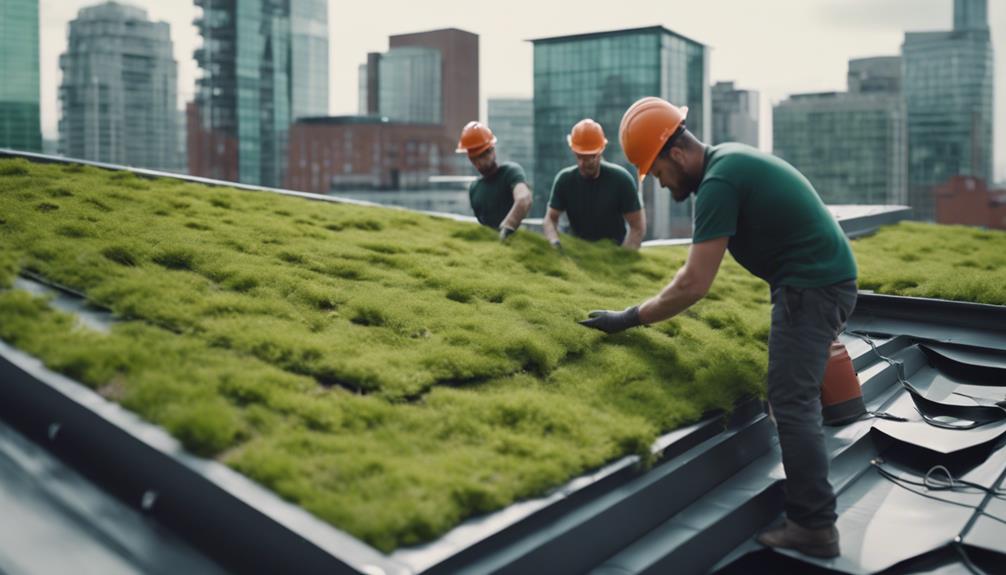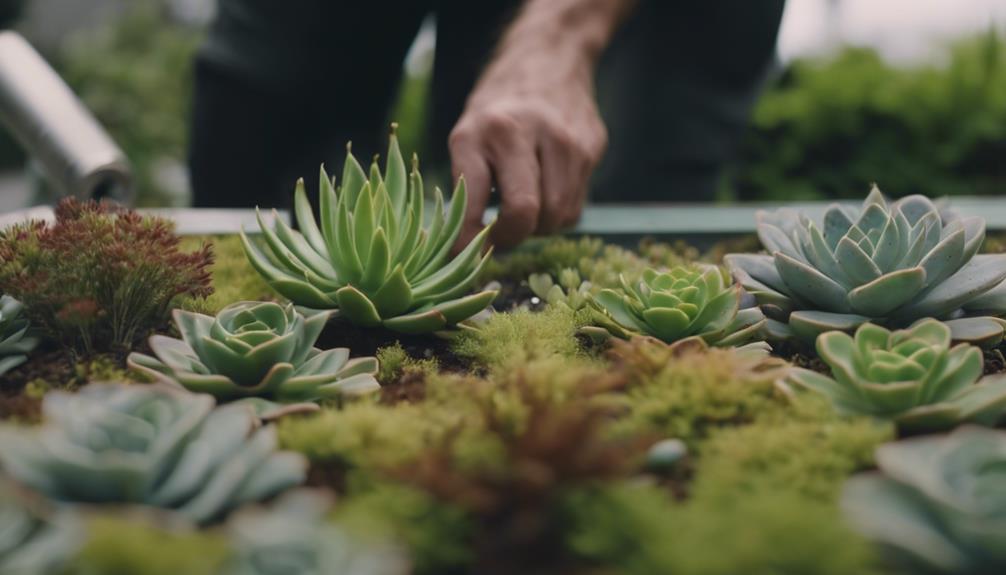How to Install a Green Roof?
Yearning to learn the secrets behind successful green roof installations?
Green roof installation offers substantial benefits beyond aesthetics, including improved insulation, extended roof lifespan, and reduced energy costs. Astral Roofing specialises in creating sustainable roofing solutions that transform ordinary buildings into eco-friendly spaces while adding significant property value.
But how do you ensure your green roof installation delivers maximum returns? What critical factors determine whether your project succeeds or fails?
In this guide, we’ll reveal the essential components of every successful green roof. You’ll discover exactly how our proven installation method has helped property owners reduce energy bills by up to 30%.
How Do You Properly Prepare the Substrate for Green Roof Installation?
Substrate preparation for green roofs involves the careful assessment and modification of the existing roof surface to create a perfect environment for the green roof system. This process starts with confirming that the roof structure can support the additional weight of the green roof components.
Once the structural integrity is confirmed, the next step is to install a waterproof membrane to protect the building from water infiltration. The membrane should be durable, flexible, and resistant to root penetration.
After the membrane is in place, a growing medium is spread over the surface to provide a suitable substrate for plant growth. The growing medium should be lightweight, well-draining, and nutrient-rich to support plant health and establishment.
Proper substrate preparation is essential for the overall success of the green roof system, as it guarantees a stable and supportive environment for the plants to thrive. By following best practices in substrate preparation, the green roof installation can achieve its full potential regarding sustainability and longevity.
How Do You Choose the Best Plants for Green Roofs?
After ensuring the structural integrity and proper installation of the waterproof membrane and growing medium, the next critical step in the green roofing process is selecting suitable plants that can thrive in the rooftop environment.
Plant selection for green roofs involves taking various factors such as the climate, sunlight exposure, wind conditions, and maintenance requirements into account. It is essential to choose plants that have shallow root systems, as they will need to adapt to the limited soil depth typically found in green roof setups.
Sedums are popular choices for green roofs due to their ability to withstand harsh conditions and drought. These succulent plants come in various colours and textures, adding aesthetic appeal to the rooftop while requiring minimal maintenance.
Grasses like Festuca and Carex are also commonly used on green roofs for their ability to form dense mats that provide both insulation and erosion control. When selecting plants for a green roof, it is critical to take their water requirements, nutrient needs, and growth habits into account to ensure a thriving and sustainable rooftop ecosystem.
What Benefits Does Professional Installation Offer for Green Roof Systems?

Professional installation of green roofing systems is important for ensuring the best performance and longevity of the vegetated roof structure. Proper installation by trained professionals is critical in guaranteeing that all components of the green roof, including the waterproof membrane, growing medium, and plant selection, work together seamlessly to provide optimal functionality.
Professionals have the expertise to assess the structural integrity of the building to determine if it can support the additional weight of a green roof. They also possess the knowledge to select the most suitable plants based on factors such as climate, sunlight exposure, and maintenance requirements.
Additionally, professional installers are well-versed in the intricacies of installing the waterproof membrane correctly to prevent leaks and water damage to the building. They can ensure that the growing medium is properly layered and distributed to support plant growth and root development.
By engaging professionals for the installation of green roofing systems, property owners can have peace of mind knowing that their investment is in good hands and will yield the environmental and economic benefits that green roofs offer.
How Often Should Maintenance Be Performed on Green Roofs After Installation?

Following the initial setup phase of green roofs, regular maintenance is generally needed just once or twice a year. Regular inspections are essential to identify any issues promptly.
This includes checking the waterproof membrane for tears or damage, making sure the growing medium is adequately retaining moisture without becoming waterlogged and monitoring the health of the plants.
Drainage upkeep is critical to prevent water stagnation, which can lead to structural damage and plant health issues. Clearing debris from drains and making sure proper slope and flow of water are important tasks.
Vegetation management is another critical aspect of green roof maintenance. Pruning plants, removing weeds, and fertilising appropriately can help maintain a healthy and vibrant green roof ecosystem.
Additionally, seeking expert guidance when necessary, such as consulting with a roofing professional or horticulturist, can provide valuable insights and ensure any maintenance issues are addressed effectively.
By staying proactive and attentive to these maintenance considerations, property owners can enjoy a thriving green roof that offers numerous environmental and economic benefits.
How Can Property Owners Plan for Green Roofs Installation?
Property owners should prioritise regular maintenance and monitoring of their green roofing system to guarantee peak performance and longevity. To secure the effectiveness and durability of your green roof, consider the following tips:
- Inspection Schedule: Establish a regular inspection schedule to detect any signs of damage, leaks, or plant health issues promptly. Inspections should cover the waterproof membrane, growing medium, and plant condition.
- Drainage Maintenance: Keep the drainage system clear of debris to prevent water stagnation and secure proper water flow off the roof. Clogged drains can lead to excess weight and potential leakage.
- Trimming and Pruning: Regularly trim and prune the vegetation on your green roof to maintain its health and aesthetics. Overgrown plants can block drainage paths and compete for resources.
- Professional Consultation: When in doubt or if issues arise, seek advice from a professional green roofing contractor or consultant to address any concerns effectively and prevent further complications.
Frequently Asked Questions
Can Green Roofing Be Installed on All Types of Buildings?
Green roofing can be installed on most buildings, but limitations may exist based on structural load capacity, building height, and local climate conditions. Factors like access for maintenance and cost must also be considered for successful implementation.
Are There Any Specific Regulations or Permits Required for Installing a Green Roof on a Residential or Commercial Building?
Specific regulations and permits are often required for installing green roofs on residential or commercial buildings. These may vary by location and can include zoning codes, building permits, environmental impact assessments, and compliance with green building standards.
How Does the Installation of a Green Roof Impact the Energy Efficiency and Insulation of a Building?
The installation of a green roof positively impacts energy efficiency and insulation by reducing heat absorption, providing natural insulation, and promoting evapotranspiration. This results in lower energy costs, improved indoor temperature regulation, and enhanced environmental sustainability.
Are There Any Special Considerations or Precautions to Take When Installing a Green Roof in a Region With Extreme Weather Conditions?
Special considerations in extreme weather regions for green roof installation include selecting plants resistant to temperature fluctuations, ensuring a durable waterproof membrane, and using a suitable growing medium that can withstand harsh conditions, such as high winds, heavy snow loads, or intense heat.
What Are the Potential Cost Savings or Financial Benefits Associated With Installing a Green Roof on a Property in the Long Run?
The potential cost savings and financial benefits of installing a green roof on a property, in the long run, include reduced energy costs due to improved insulation, extended roof lifespan, decreased stormwater runoff leading to lower maintenance expenses, and potential tax incentives for green building initiatives.